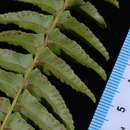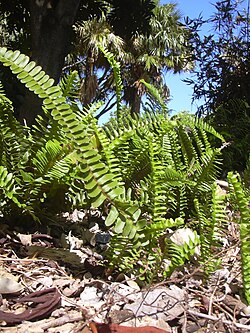mk
имиња во трошки


Nephrolepis cordifolia ist eine Pflanzenart aus der Gattung der Schwertfarne (Nephrolepis). Sie ist ursprünglich in den Tropen beheimatet, ist jedoch eine beliebte Zimmerpflanze.
Nephrolepis cordifolia ist ein immergrüner Farn, der Wuchshöhen zwischen 40 und 80 Zentimeter, in Extremfällen bis zu 1 Meter, erreicht. Er bildet ein unterirdisches Rhizom in der Gestalt mehrerer kleiner Knollen aus. Die gefiederten Wedel stehen aufrecht und sind linealisch bis lanzettlich, drüsig und einfach gefiedert. Die Rhachis trägt zweifarbige Spreuschuppen.
Die Fiederblättchen sind ganzrandig, ungestielt und länglich-lanzettlich. Sie werden bis zu 4,8 Zentimeter lang und bis zu 0,9 cm breit. Sie stehen in einem Abstand von weniger als 1 Zentimeter. Die Sori sind rundlich. Die Sporen sind warzig, faltig.
Nephrolepis cordifolia können sowohl terrestrisch als auch als Epiphyt wachsen. Als Epiphyt ist die Art aber sehr selten.
Natürlich kommt Nephrolepis cordifolia in Australien und an den Hängen des Himalayas vor.[1] Als Neophyt konnte sich die Art jedoch in Teilen der Vereinigten Staaten (Florida, Georgia, Alabama und Hawaii), sowie in Neuseeland, auf den Azoren und den Gesellschaftsinseln ausbreiten. In den USA wird die Art als invasive Pflanze bekämpft. In Neuseeland ist die Art im National Pest Plant Accord gelistet, sodass ein Verkauf, Vermehrung und Vertrieb der Pflanze untersagt ist.[2]
Sie liebt feuchte, schattige Standorte und findet sich häufig in Sümpfen und Überschwemmungsgebieten in Nadelwäldern.
Nephrolepis cordifolia ist eine Pflanzenart aus der Gattung der Schwertfarne (Nephrolepis). Sie ist ursprünglich in den Tropen beheimatet, ist jedoch eine beliebte Zimmerpflanze.
पानीअमला पोथ्रा वर्गमा पर्ने एक प्रकारको फुल नफुल्ने वनस्पति हो। पानीअमला जंगलभित्र घाम नदेखीने ठाँउमा फल्छ। यसलाई औषधीको रुपमा पनि प्रयोग गरिन्छ।
पानीअमला पोथ्रा वर्गमा पर्ने एक प्रकारको फुल नफुल्ने वनस्पति हो। पानीअमला जंगलभित्र घाम नदेखीने ठाँउमा फल्छ। यसलाई औषधीको रुपमा पनि प्रयोग गरिन्छ।
Nephrolepis cordifolia, is a fern native to the global tropics, including northeastern Australia and Asia. It has many common names including fishbone fern, tuberous sword fern, tuber ladder fern, erect sword fern, narrow sword fern and ladder fern, and herringbone fern.[1] It is similar to the related fern Nephrolepis exaltata.
Nephrolepis cordifolia is an evergreen fern that grows to between 40 and 80 centimeters, in extreme cases up to 1 meter. It forms an underground rhizome in the form of several small tubers. The pinnate fronds are erect and pinnate linear to lanceolate, glandular and simple. The rachis bears bicolored chaff scales. The petiole is covered with bicolored pale and dark brown scales.
The leaflets are entire, sessile and elongate-lanceolate. They grow up to 4.8 centimeters long and up to 0.9 cm wide. They stand at a distance of less than 1 centimeter. The sori are rounded. The spores are warty, wrinkled.
The species is originally native to north-eastern Australia and the foothills of the Himalayas, and is considered naturalised on the central east coast of New South Wales. They can establish themselves terrestrially, or as an epiphyte or lithophyte, provided that the location has ideal moisture and light levels. In adequate conditions, these ferns grow readily as epiphytes, typically adhering to the bark of tree branches above a water source, where they can receive round-the-clock humidity and airflow. They can be found in a multitude of environments, from deep swamps and riverbanks to rugged outcrops and rock faces, as well as roadsides, ditches, creeks, fallen trees, and even abandoned buildings and ruins. They love moist, shady locations; in their natural range, they are usually found in swamps (as an epiphyte) or along brooks and ditches of coniferous forest floodplains (growing more terrestrially).
It has been introduced into Bermuda, French Polynesia, New Zealand, and the United States.[2] It is also widely cultivated and distributed by humans, currently found in tropical regions of North, Central and South America (mainly in Mexico, the Caribbean, plus parts of California and Florida), in Africa, Southeast Asia, various South Pacific islands and on the Azores. In the Hawaiian Islands, it is known as kupukupu, okupukupu or ni'ani'au [3]
Nephrolepis cordifolia has become an invasive species is some areas where it has been introduced. In New Zealand it is listed on the National Pest Plant Accord, which prohibits the sale, cultivation and distribution of the plant. It is listed as an invasive species in Florida, United States.[4]
'Nephrolepis cordifolia spreading on a forest and pasture margin in the Waikato region in New Zealand
Nephrolepis cordifolia 'Duffii' at Garfield Park Conservatory
Nephrolepis cordifolia at the New York Botanical Garden
Nephrolepis cordifolia, is a fern native to the global tropics, including northeastern Australia and Asia. It has many common names including fishbone fern, tuberous sword fern, tuber ladder fern, erect sword fern, narrow sword fern and ladder fern, and herringbone fern. It is similar to the related fern Nephrolepis exaltata.
El helecho serrucho (Nephrolepis cordifolia[1]) es una especie que ha sido ubicada en diversas familias, como Dryopteridaceae, Davalliaceae y Nephrolepidaceae, esto dependiendo del autor o clasificación. El nombre del género Nephrolepis se deriva del griego y hace referencia a las escamas en forma de riñón de la planta, mientras que la especie hace referencia a la forma de las hojas.[2][3]
Planta terrestre; rizomas erectos, estoloníferos a menudo con tubérculos; peciolos de 9 a 18 cm de largo; frondas firmes, herbáceas, linear-elípticas; pinnas angostamente deltadas, ápices agudos, bases desiguales, margen crenado, venas indistintas; indusio reniforme a lunado de color café.[4][3]
En México se ha colectado en Chiapas, Ciudad de México, Estado de México, Oaxaca, Puebla y Veracruz; ocurre también en Estados Unidos, Guatemala, Honduras, Panamá, Perú, Brasil y en los trópicos del viejo mundo, esta especies probablemente no es nativa de México.[4]
Es de ambiente terrestre y habita en bosques de diversos tipos.[4]
En México se le considera bajo la categoría de “En Peligro de Extinción” (P) según la NOM-059-SEMARNAT-2010, mientras que la especie no ha sido evaluada por la Lista Roja de especies amenazadas de la IUCN. Ni en CITES (Convención sobre el Comercio Internacional de Especies Amenazadas de Fauna y Flora Silvestres).
El helecho serrucho (Nephrolepis cordifolia) es una especie que ha sido ubicada en diversas familias, como Dryopteridaceae, Davalliaceae y Nephrolepidaceae, esto dependiendo del autor o clasificación. El nombre del género Nephrolepis se deriva del griego y hace referencia a las escamas en forma de riñón de la planta, mientras que la especie hace referencia a la forma de las hojas.
Nephrolepis cordifolia is een varen uit de familie Nephrolepidaceae. Het is een epifytische of terrestrische plant uit tropische streken, die wereldwijdverbreid is.
De botanische naam Nephrolepis is afkomstig uit het Oudgriekse νεφρός, nephros (nier) en λεπίς, lepis (schub), naar de vorm van de dekvliesjes. De soortaanduiding komt van het Latijnse cor (hart) en folium (blad), naar de hartvormige voet van de bladslipjes.
Nephrolepis cordifolia is een middelgrote varen met een dikke, rechtopstaande rizoom voorzien van stengelknolletjes. De bladen zijn tot 1 m lang, onbehaard, enkelvoudig geveerd, met tot 5 cm lange, lancetvormige, langwerpige of licht sikkelvormige bladslipjes met gave, fijn gezaagde tot fijn getande bladranden, een hartvormige bladvoet en een afgeronde tot spitse bladtop. De bladsteel is bedekt met tweekleurig bleek- en donkerbruine schubben.
De sporenhoopjes zitten aan de onderzijde van de bladen tussen de bladrand en de nerven en worden beschermd door halvemaanvormige tot afgerond driehoekige dekvliesjes.
Nephrolepis cordifolia groeit vooral in vochtige, schaduwrijke bosjes, rotswanden, bermen, op oude muren of ruïnes.
De plant is wijdverbreid door de mens en komt momenteel voor in tropische streken van Noord-, Midden- en Zuid-Amerika (voornamelijk in Mexico, de Caraïben en Florida), in Afrika, Zuidoost-Azië, de eilanden van de Stille Oceaan en op de Azoren.
Bronnen, noten en/of referentiesNephrolepis cordifolia is een varen uit de familie Nephrolepidaceae. Het is een epifytische of terrestrische plant uit tropische streken, die wereldwijdverbreid is.
Nephrolepis cordifolia é uma espécie de feto pertencente à família Nephrolepidaceae.[1]
A autoridade científica da espécie é (L.) C. Presl, tendo sido publicada em Tentamen Pteridographiae 79. 1836.[2][3]
Trata-se de uma espécie presente no território português, nomeadamente no Arquipélago da Madeira. Ocorre na Ilha da Madeira, não ocorrendo na ilha de Porto Santo, nas Selvagens e nas Desertas.[4]
Em termos de naturalidade é introduzida na região atrás referida.
Há também registo de ser uma espécie naturalizado no Arquipélago dos Açores, ocorrendo em todas as ilhas com excepção da Ilha do Corvo.[5][6]
Não se encontra protegida por legislação portuguesa ou da Comunidade Europeia.
De acordo com a base de dados The Plant List, tem os seguintes sinónimos:
Nephrolepis cordifolia é uma espécie de feto pertencente à família Nephrolepidaceae.
A autoridade científica da espécie é (L.) C. Presl, tendo sido publicada em Tentamen Pteridographiae 79. 1836.
Nephrolepis cordifolia là một loài dương xỉ trong họ Nephrolepidaceae. Loài này được L. C. Presl mô tả khoa học đầu tiên năm 1836.[1]
Nephrolepis cordifolia là một loài dương xỉ trong họ Nephrolepidaceae. Loài này được L. C. Presl mô tả khoa học đầu tiên năm 1836.
腎蕨(學名:Nephrolepis cordifolia or Nephrolepis auriculata),腎蕨科腎蕨屬,又名蜈蚣草、山雞蛋、羊齒、鐵雞蛋、凰凰蛋、鹽雞蛋、山檳榔、玉羊齒,英文名Tuberous Sword Fern。因其孢子囊形狀如同腎臟之形,(一說是因其球莖如腎)故有「腎蕨」之名。腎蕨原產於澳大利亞北部、夏威夷和亞洲[1][2],它是良好的插花材料。此外还為重要的取水植物,於野外可補充水份;嫩芽及球莖可食。其塊莖治淋巴結核、解熱等,並有解毒之功效,主治瘰癧、瘡癤、癰腫等。由于其生长环境要求不高,因此几乎无处不可生长,在一些地方甚至成為入侵物種。
腎蕨(學名:Nephrolepis cordifolia or Nephrolepis auriculata),腎蕨科腎蕨屬,又名蜈蚣草、山雞蛋、羊齒、鐵雞蛋、凰凰蛋、鹽雞蛋、山檳榔、玉羊齒,英文名Tuberous Sword Fern。因其孢子囊形狀如同腎臟之形,(一說是因其球莖如腎)故有「腎蕨」之名。腎蕨原產於澳大利亞北部、夏威夷和亞洲,它是良好的插花材料。此外还為重要的取水植物,於野外可補充水份;嫩芽及球莖可食。其塊莖治淋巴結核、解熱等,並有解毒之功效,主治瘰癧、瘡癤、癰腫等。由于其生长环境要求不高,因此几乎无处不可生长,在一些地方甚至成為入侵物種。

タマシダ(玉羊歯、学名:Nephrolepis cordifolia)は、ツルシダ科に属するシダ植物で、日本の南部に生育する。乾燥した地面や、樹上にはえ、時に観賞用に栽培される。
茎はごく短く、ほぼ直立して、多数の葉をつける。茎からは針金のような根とともに、細い匍匐茎を出し、新しい芽をつけ、大きな群落になる。また、匍匐茎には球状の固まりをところどころに着ける。これは、水を蓄えるためのものと考えられ、玉羊歯の名もこれによるものである。
葉は細長く、普通は30-40cm、長いものは80cmにも達する。地上のものでは葉はやや立ち上がり、樹上についたものでは、葉は垂れ下がる。葉は一回羽状複葉で、主軸の左右に細長い楕円形の小葉を数十対、時には百対もつける。胞子のう群は小葉の裏側、主脈と葉縁との間に並ぶ。
日本では、本州の伊豆半島から九州、小笠原諸島、南西諸島に、日本国外では、中国や台湾、東南アジア、ポリネシア、アフリカ等に分布する[1]。
主に海岸近くの日当たりのよい場所に生育する。 海岸付近の乾いた斜面や、岩の上、場合によっては樹上に着生する。特に海岸沿いに植えられた街路樹のカナリーヤシの葉の集まった部分には、よくタマシダが密生している。
観葉植物として栽培されることがある。近縁種のセイヨウタマシダ (N. exaltata (L.) Schott) は、南米原産で、観葉植物として改良されたものがあり、学名のままにネフロレピス・エクサルタータとか、ボストンファーンとか呼ばれる。小葉がさらに羽状に切れ込んだものなどがよく見かけられる。本種にも園芸品種はあり、ダッフィー 'Duffii' は、羽片がごく短くなった変異で、葉全体の幅は1-1.5cmにしかならない。中軸は時に二股分枝し、羽片は扁円形から半円まで不規則に変化し、胞子嚢群を滅多につけない[2]。これはニュージーランドあるいは南洋諸島が原産とされ、本種よりの変異と思われる。和名としては石化タマシダ(セッカタマシダ表記も)がある[3]。
日本にはこの他に2種あり、タマシダに似てやや小葉が大きい感じのヤンバルタマシダ (N. hirstula (Forst.) Presl) が南西諸島と小笠原諸島に分布する。もう一種のホウビカンジュ (N. biserata (Sw.) Schott) は、南西諸島に分布し、石灰岩の崖などに生えて、小葉はより幅広く大きく、垂れ下がって長さが2mにも達する。名前の由来は鳳尾貫衆で、貫衆は中国語でヤブソテツなどを指すとのこと。